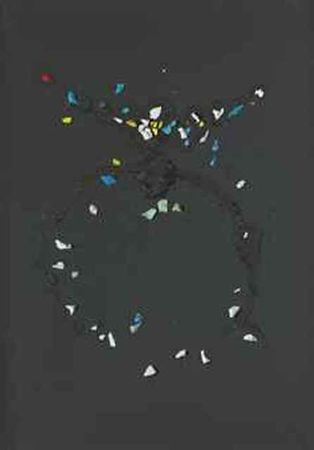Lucio Fontana (1899-1968), Concetto spaziale.
Lucio Fontana (1899-1968), Concetto spaziale. Photo: Christie's Images Ltd., 2011
signed and dated 'l. Fontana 54' (lower right); signed and dated 'l. Fontana 54' (on the reverse), oil and coloured glass stones on canvas , 39 3/8 x 27 5/8in. (100 x 70cm.). Executed in 1954 - Estimare £700,000 - £1,000,000 ($1,124,900 - $1,607,000
Provenance: Private Collection, Italy (acquired directly from the artist).
Acquired from the above by the present owner circa 1995.
Literature: M. Tapié, Devenir de Fontana, Turin 1961 (illustrated in colour, unpaged).
E. Crispolti, Lucio Fontana: catalogue raisonné des peintures, sculptures et environnements spatiaux, vol. II, Brussels 1974, no. 54 P 12 (illustrated, p. 34).
E. Crispolti, Lucio Fontana: catalogo generale, vol. I, Milan 1986, no. 54 P 12 (illustrated, p. 126).
E. Crispolti, Lucio Fontana: catalogo ragionato di sculture, dipinti, ambientazioni, vol. I, Milan 2006, no. 54 P 12 (illustrated, p. 266).
Exhibited: London, Institute of Contemporary Art, Paintings from the Damiano Collection, 1959, no. 3.
Leverkusen, Städtisches Museum, Schloss Morsbroich, Lucio Fontana, 1962, no. 19.
Notes: 'The new art takes its elements from nature. Existence, nature and matter form a perfect unity. They develop in space and time. Change is an essential condition of existence. Movement - the property of evolving and developing - is the basic condition of matter. Matter exists in movement and only in movement. Its development is eternal. In nature, colour and sound are found only as part of matter. The simultaneous movement of the phenomena of matter, colour and sound is what gives wholeness to the new art.'
(Lucio Fontana, 'Manifesto Blanco', in Lucio Fontana exh. cat,. Rome 1998, p. 115).
With its shimmering play of coloured light scattering and dispersing amongst the linear patterns of spatial emptiness and dense conglomerated matter, this work - Concetto spaziale (spatial concept) from 1954 - is one of a select group of works in which the full elaboration of Fontana's spatialist art is most completely combined. One of only a small group known as the 'Pietri' (Stones), made between 1953 and 1955 in which Fontana both added colourful 'stones' - in fact made of coloured porcelain and glass - to the surface of his work, and embedded into a dense and overtly material mass of oil paint, this particularly astrallooking 'spatial concept' articulates a complex play of form, space, colour and light. Using a fusion of intuitive informel technique and the ephemeral qualities of his earlier, distinctly Baroque sculpture, Fontana - the Spatialist master and trained sculptor - has here dramatically explored
to the full the sculptural and spatial potential of painting and the twodimensional canvas.
In 1954, in addition to the scattering of stones on the surface of his paintings, Fontana, as in this work, also began to create strange material conglomerations of matter in and amongst his sparkling constellations of holes and shining stones, using thickly-pasted oil paint in a semi-formed and sometimes even diagrammatic or cipher-like way. In this work, Fontana has not only pierced the canvas with his 'holes', tracing spatialist lines across the flat canvas surface, but this sequential progression of voids punctuates a more elaborate and intriguingly textural play of light and matter taking place above the canvas plane in the space of the viewer.
Arranged into two arcing constellations of form reminiscent perhaps of two planetary entities coming into a near eclipse-like proximity, the seemingly random but in fact carefully placed scattering of radiantly
coloured glass and porcelain fragments embedded in this 'dark matter' creates two puzzling and seemingly interconnecting and constellationlike clusters of form. Taking on more fully the pictorial ambience of the cosmos than many of his previous works, the combination of punctured buchi and the apparently random scattering of 'pietri' into multidimensional cloud-like constellations in this 1954 pietri suggests a pervasive sense of light, space and material all perpetually colliding in a constant flux of motion set against an apparently infinite monochrome black void.
'When I began using the stones,' Fontana said, 'I wanted to see if I could move forward...I thought that with the stones, the light would flow better - that it would create more the effect of movement' (Lucio Fontana, 1967, quoted in Lucio Fontana, exh. cat. London, 1999, p. 17). It was Fontana's intention with the addition of the pietri to his canvases to open up further the surface of the painting to a multi-dimensional play of light, colour, movement and material as a formalised extension of the way that his 'cuts' and 'holes' had infused the flat two-dimensional plane of the canvas to the infinite dimension of Space. Inspired by the light, space and motion work of avant-garde pioneers such as Laszlo Moholy-Nagy, Fontana wanted also to incorporate such an elemental expression of the fundamental properties of the cosmos into his work. The addition of 'pietri' to his canvases would, he hoped, infuse the surface of his canvases with the disparate elements of light and motion as the light and colour contrasted, reflected and sparkled off the jewellike coloured glass in such a way as to suggest a new multi-dimensional sense of astral space.
Christie's. Post-War and Contemporary Art Evening Auction. 16 February 2011. London, King Street www.christies.com

/https%3A%2F%2Fprofilepics.canalblog.com%2Fprofilepics%2F1%2F0%2F100183.jpg)
/https%3A%2F%2Fstorage.canalblog.com%2F03%2F02%2F119589%2F96711876_o.jpg)
/https%3A%2F%2Fstorage.canalblog.com%2F11%2F31%2F119589%2F94773502_o.jpg)
/https%3A%2F%2Fstorage.canalblog.com%2F20%2F83%2F119589%2F94772815_o.jpg)
/https%3A%2F%2Fstorage.canalblog.com%2F26%2F72%2F119589%2F75604929_o.jpg)
/https%3A%2F%2Fstorage.canalblog.com%2F59%2F60%2F119589%2F26458628_o.jpg)



/image%2F1371349%2F20240313%2Fob_3da818_431115881-1632814154155264-57534444325.jpg)
/image%2F1371349%2F20240312%2Fob_cc9c83_f2.jpg)
/image%2F1371349%2F20240311%2Fob_2edda2_fontana.jpg)
/http%3A%2F%2Fstorage.canalblog.com%2F86%2F67%2F119589%2F129815803_o.png)